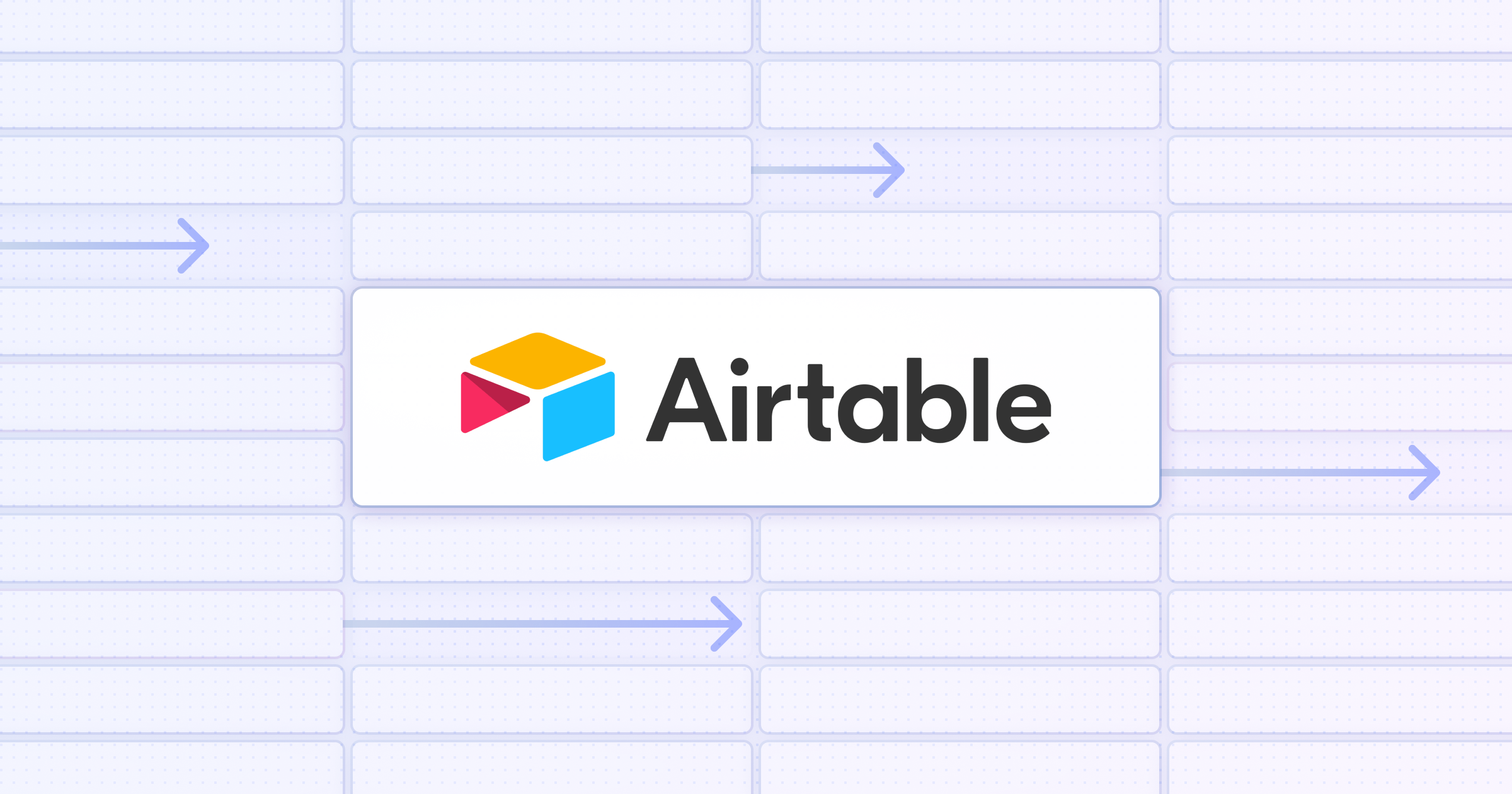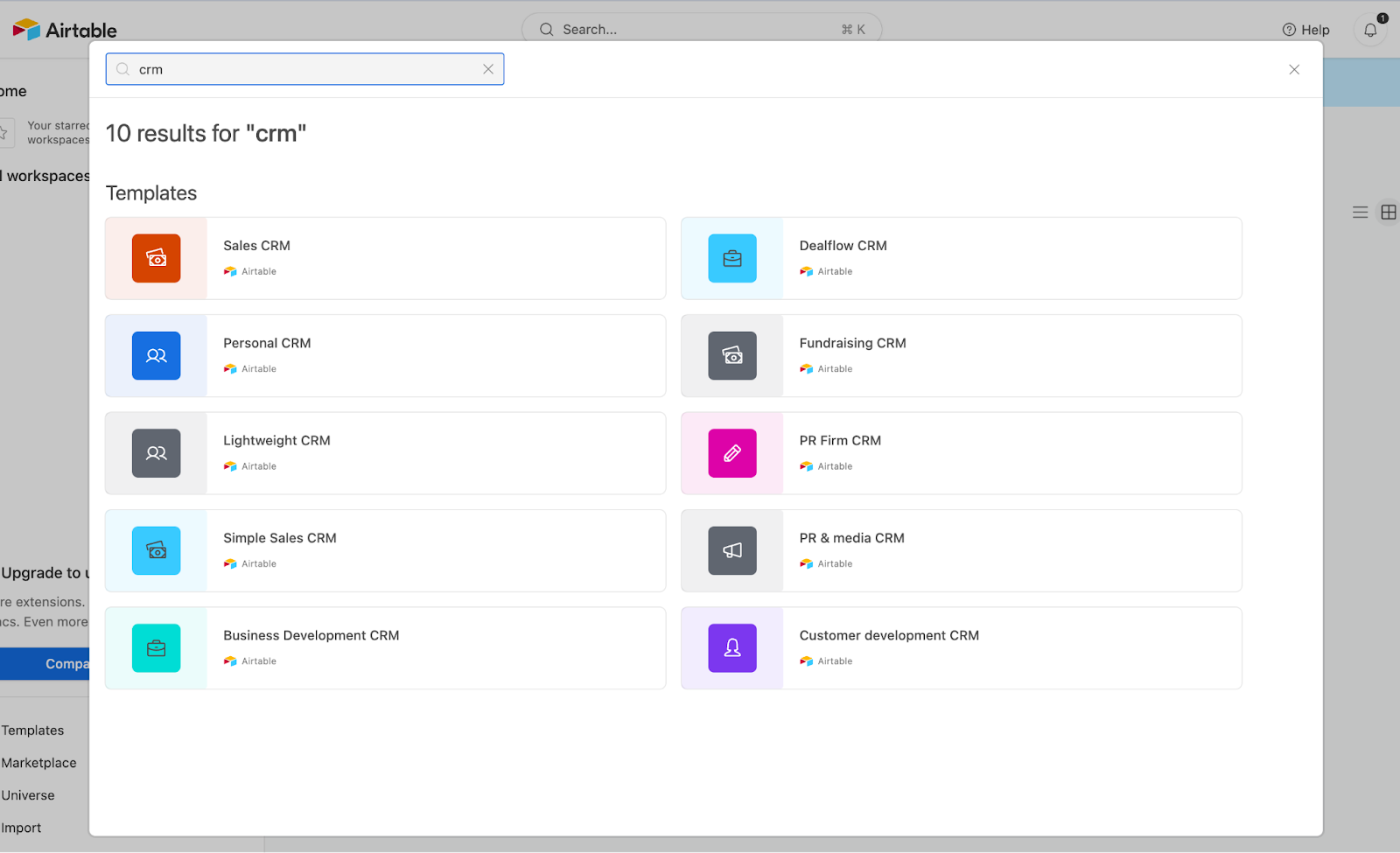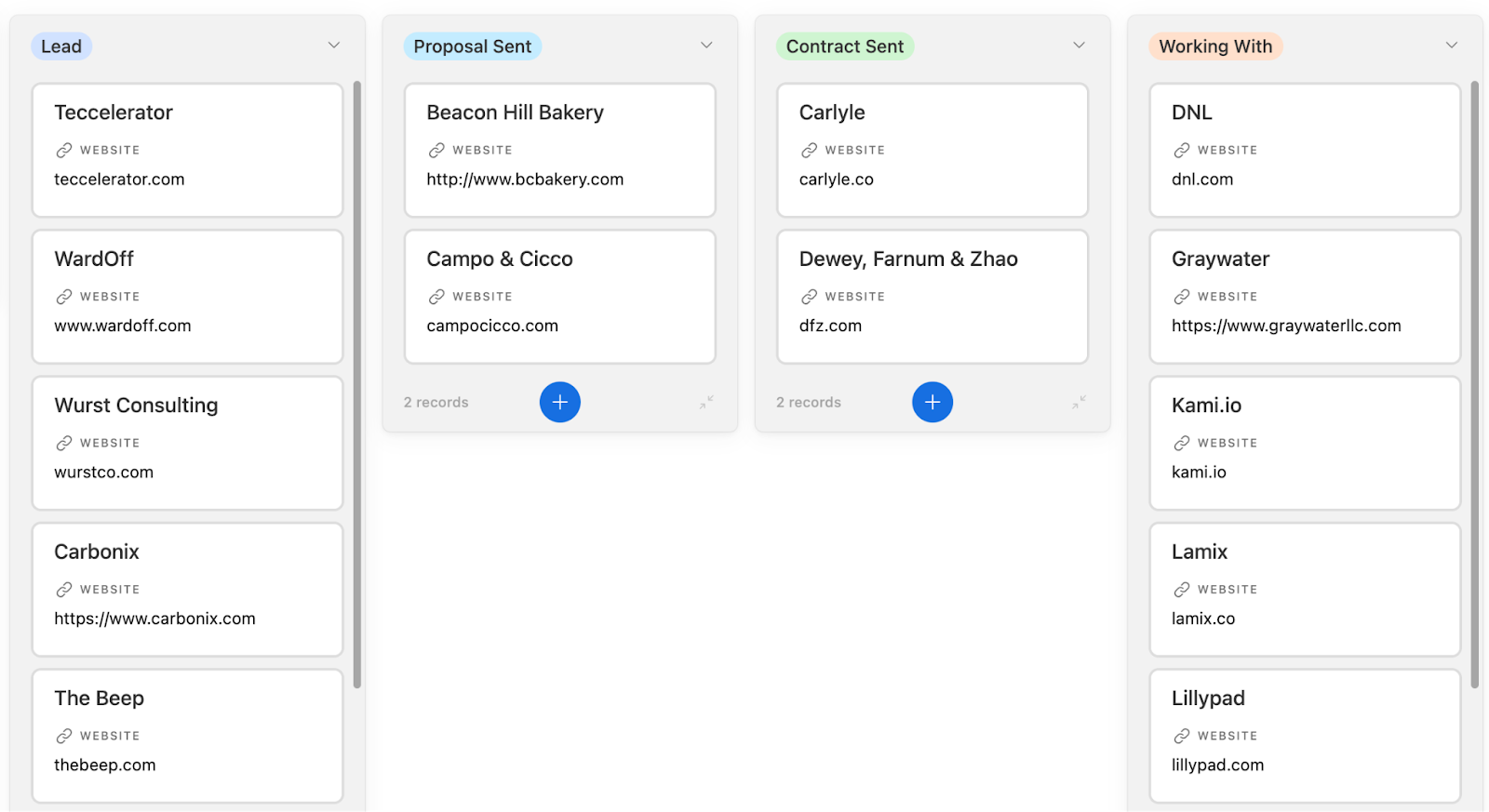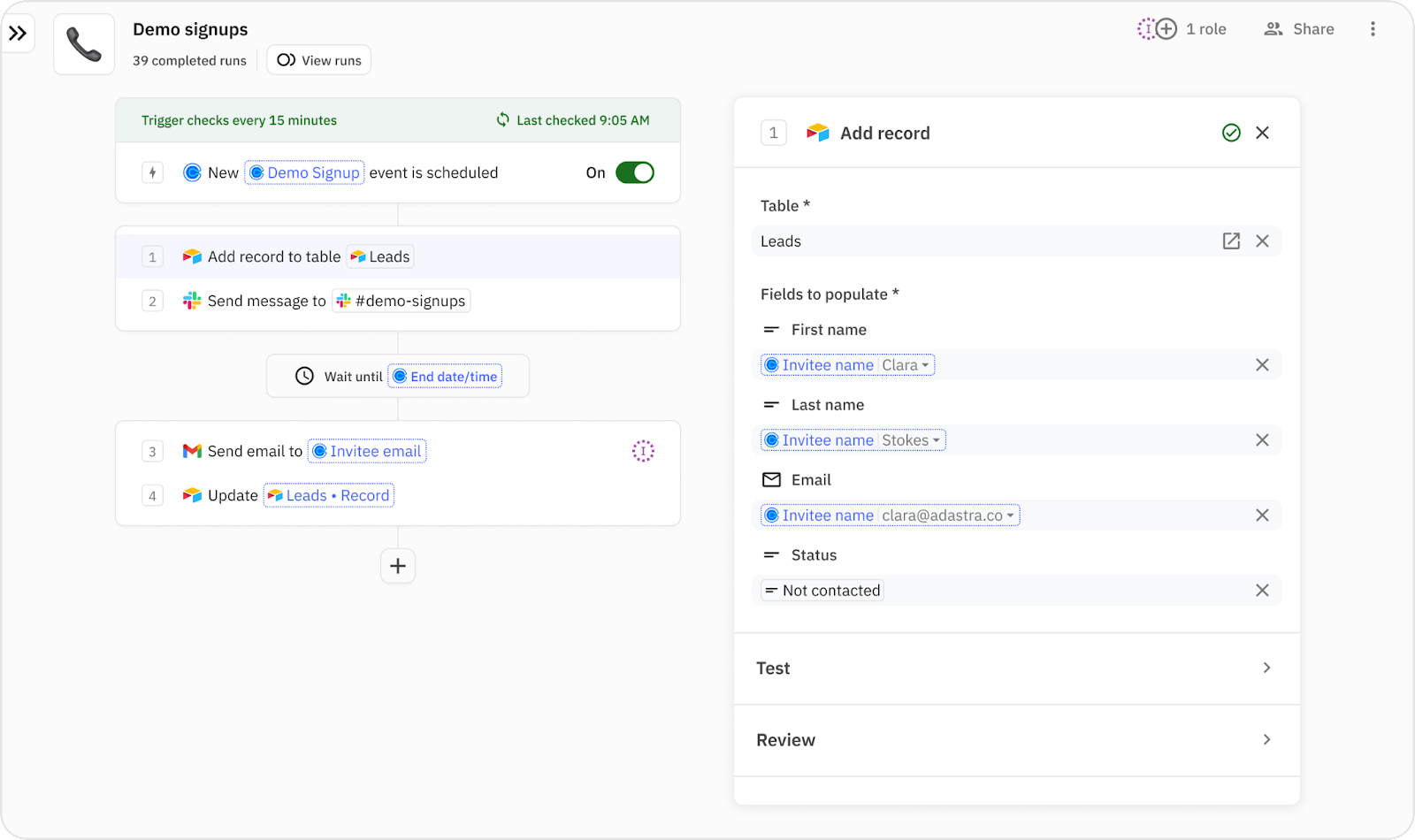
We’ve all heard the tagline—Airtable combines the simplicity of a spreadsheet with the power of a database. Unlike most marketing slogans, Airtable actually keeps the promise. It’s a great tool with an easy-to-use interface that manages to make data management less monotonous (maybe even fun?!).
This is why it’s become a go-to for folks seeking refuge from clunky, expensive, traditional Customer Relationship Management (CRM) systems. Airtable CRMs allow you to have your cake and eat it too, except in this case, the cake organizes customer data in a visually appealing and manageable way.
But Airtable isn’t a CRM out of the box, so it can take a couple of tweaks to set up. So, here’s a guide to help you get started—and a few automated workflows you can create with Relay to get even more out of your Airtable CRM.
Why build an Airtable CRM?
Building a CRM with Airtable offers a unique blend of flexibility, power, and user-friendliness that stands in stark contrast to traditional CRM systems (anyone who has ever used Salesforce will let you know!)
Here's why it's worth considering for your customer relationship management needs:
- Customization at its core. Unlike conventional CRMs, Airtable allows you to tailor your database precisely to your business's unique workflows and data requirements. This means you can create a CRM that reflects the specific nuances of your operations and grows alongside your business.
- A user-friendly interface. Airtable combines the simplicity of spreadsheets with the robust capabilities of a database, making data management more accessible and, surprisingly, enjoyable. Its intuitive design and visual appeal facilitate collaboration and make the process of entering and managing data far less tedious.
- Cost-effective. For small to medium-sized enterprises (SMEs) and startups, Airtable presents a cost-effective alternative to the often expensive and rigid traditional CRM systems. It provides significant value without the hefty price tag, making sophisticated data management achievable for businesses of all sizes.
- Great for collaboration. Airtable's platform is built with collaboration in mind, enabling teams to work together seamlessly on the CRM. Real-time updates, customizable views, and shared access ensure everyone is on the same page, enhancing teamwork and efficiency.
- A huge range of features. With features like rich field types, customizable views, and easy integration capabilities, Airtable transforms the static concept of a CRM into a dynamic, interactive tool. This not only drives engagement but also provides valuable insights for strategic decision-making.
Just one thing before we move on: Airtable as a CRM is pretty great, but let's be real—it's not for everyone. For the big leagues with super complex CRM needs, Airtable might feel a bit like bringing a knife to a gunfight. But for startups wanting to get the most bang for their buck, or freelancers watching their pennies, Airtable is a fantastic choice. It all boils down to what your business needs, how big you are, and where you're headed. Now on with the show.
How to use Airtable as a CRM
Here's a step-by-step guide to setting up your CRM in Airtable:
1. Choose a CRM Template
So if we were trying to appease the SEO gods we would rant on about setting up your own CRM from scratch, and waste hundreds of words getting to the point. We aren’t going to do that. Airtable offers a bunch of pre-built templates tailor-made just for this purpose. Sure, you have to edit them a bit, but they come equipped with 80% of what you’ll need—use them!
Once you’ve created a free Airtable account, you’ll find Templates at the bottom of the sidebar. Click Templates and search “CRM” to see the collection of CRM templates. Click Try this Template to add it to your workspace.

Here are a few that we liked:
If you prefer a more tailored approach, you can start from scratch and build your CRM base to suit your exact requirements. This involves setting up fields for contacts, companies, interactions, and any other relevant data you wish to track, which we’ll get to in the next step.
2. Customize your fields
Customize the fields in your template to match the data you need to track. For this tutorial, we chose the “Lightweight CRM” template, which offers a good baseline. Most CRMs will require a name, email, phone number, and website, but you can customize it with any data you require (or don’t require).
For example, the template we used lists the number of employees at each company. For this scenario, we’re going to build a simple personal CRM, so that information isn’t relevant. We traded it out for a “status” field that shows where the company is along the pipeline.

One of the beauties of Airtable is that it allows you to use various field types—from text, number, and date fields, to checkboxes and multi-select tags. Use these to easily capture and curate different types of information (e.g. a select field for stages in the sales funnel, or a checkbox for lead qualification).
3. Import your existing customer information
When you’ve settled on the layout of your CRM it’s time to import any existing data from a previous CRM, or another data source, like that outdated Google Sheets file you used to use. (Note: if you’ve used a template, now is the time to delete the dummy data)
There’s a handy import tool that helps with this, but you’ll still have to do some manual checks to make sure data is mapped correctly to the corresponding fields in Airtable.

4. Set up custom filters and views
Airtable’s views allow you to see your data in different formats, from a basic grid to a calendar or a trusty Kanban board. Views are a fantastic tool—they work off the single set of data, but let you to see and interact with that data in different ways.
For example, you can use the Kanban board to track your progress with leads, then switch to the calendar view to manage follow-up tasks. You can also use conditional filters to organize data even more and enter a whole new level of Airtable-nerdery.

Get the most out of your Airtable CRM with Relay
You’ve got yourself a basic Airtable CRM! Now it’s time to expand the functionality to get even more out of it, and go further towards plugging those gaps between dedicated CRMs like Salesforce and HubSpot, while also just making life easier all around.
Of course, we suggest Relay to do this. The manual workload involved in maintaining a CRM can be overwhelming, leading to inefficiencies and potential errors. Not to mention logging each interaction, creating and managing documents, and updating your team (or other tools). Relay directly addresses these pain points by automating those critical processes.

Let’s dive into how Relay can set your Airtable CRM on autopilot, making every interaction and workflow seamless and smart.
Capture and sort leads
Relay can channel leads from sources like Typeform, Mailchimp, and Facebook directly into your Airtable. It smartly categorizes each lead, using any details you require—from Shopify interests to location data—ensuring your follow-up is as targeted as it gets.
Track every interaction
Relay keeps tabs on all customer interactions for you, from Gmail communications to Zoom calls. It can even nudge you with Slack reminders for that personal touch at just the right moment, making sure no lead or customer feels left out.
Customize your customer journey
Turn Relay into your personal marketing wizard. Segment customers in Airtable based on their journey—from Facebook ad clicks to Stripe purchases—and let Relay tailor your outreach on platforms like SendGrid. It’s all about hitting the right note at every stage of the customer lifecycle.
Keep your team in the loop
With Relay, you can integrate with Slack so your team gets instant updates, or get emails about vital CRM moves. Prefer to keep your inbox clear? Delegate tasks in Todoist or Asana, based on new sign-ups or inquiries, keeping your team’s workflow smooth and balanced.
Let AI do the number crunching
Our built-in AI analyzes and summarizes key insights, directly enriching your Airtable CRM with invaluable information. This means your customer strategies are always informed, up-to-date, and backed by the latest AI-driven data analysis, keeping you ahead of the curve with minimal effort.
Over to you
By integrating Relay with your Airtable CRM, you not only streamline your CRM processes but also unlock the full potential of your customer relationship management system, ensuring that you can focus on what truly matters—building and nurturing customer relationships.
So what are you waiting for? Set up your Airtable CRM, then give Relay a try for free and see how automation can simplify your work life.









